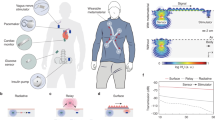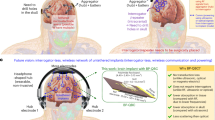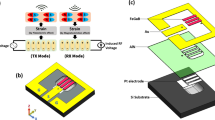Abstract
Exceptional points are degeneracies in physical systems at which both the underlying eigenvalues and eigenvectors of the system coalesce. They originated in theoretical explorations of quantum mechanics, but are of increasing value in photonics, acoustics and electronics because their emergence in physical systems with controlled gain and loss can dramatically alter the response of a system. In particular, systems biased at exceptional points can exhibit an amplified response to a small perturbation, enabling greatly enhanced sensitivity for certain resonant sensors. In biomedicine, implanted electronic sensors based on resonant inductor–capacitor (LC) circuits can be used to monitor internal physiological states, but their capabilities are currently limited by the low sensitivity of existing wireless interrogation techniques. Here we show that a reconfigurable wireless system locked to an exceptional point can be used to interrogate in vivo microsensors with a sensitivity 3.2 times the limit encountered by existing schemes. We use a controller that maximizes the abruptness of a parity–time-symmetry phase transition to operate a reconfigurable circuit at an exceptional point and maintain enhanced sensitivity. With this approach, we demonstrate robust readout of LC microsensors (with diameters of 900 μm) that are subcutaneously implanted in a rat, and show that it can be used for wideband sensor interrogation for measurement of the resonant frequencies of single and multiple sensors.
This is a preview of subscription content, access via your institution
Access options
Access Nature and 54 other Nature Portfolio journals
Get Nature+, our best-value online-access subscription
$29.99 / 30 days
cancel any time
Subscribe to this journal
Receive 12 digital issues and online access to articles
$119.00 per year
only $9.92 per issue
Buy this article
- Purchase on Springer Link
- Instant access to full article PDF
Prices may be subject to local taxes which are calculated during checkout





Similar content being viewed by others
Data availability
The data that support the plots within this paper and other findings of this study are available from the corresponding author upon reasonable request.
Code availability
Pseudocode for the EP-locking algorithm is provided in the Supplementary Information.
References
Collins, C. C. Miniature passive pressure transensor for implanting in the eye. IEEE Trans. Biomed. Eng. 14, 74–83 (1967).
Chen, P.-J., Rodger, D. C., Saati, S., Humayun, M. S. & Tai, Y.-C. Microfabricated implantable parylene-based wireless passive intraocular pressure sensors. J. Microelectromech. Syst. 17, 1342–1351 (2008).
Abraham, W. T. et al. Wireless pulmonary artery haemodynamic monitoring in chronic heart failure: a randomised controlled trial. Lancet 377, 658–666 (2011).
Mannoor, M. S. et al. Graphene-based wireless bacteria detection on tooth enamel. Nat. Commun. 3, 763–768 (2012).
Chen, L. Y. et al. Continuous wireless pressure monitoring and mapping with ultra-small passive sensors for health monitoring and critical care. Nat. Commun. 5, 5028 (2014).
Hu, X. et al. Micrometer-scale magnetic-resonance-coupled radio-frequency identification and transceivers for wireless sensors in cells. Phys. Rev. Appl. 8, 014031–13 (2017).
Miri, M.-A. & Alu, A. Exceptional points in optics and photonics. Science 363, eaar7709 (2019).
Feng, L., El-Ganainy, R. & Ge, L. Non-Hermitian photonics based on parity–time symmetry. Nat. Photon. 11, 752–762 (2017).
Wiersig, J. Sensors operating at exceptional points: general theory. Phys. Rev. A 93, 033809 (2016).
Liu, Z.-P. et al. Metrology with PT-symmetric cavities: enhanced sensitivity near the PT-phase transition. Phys. Rev. Lett. 117, 110802 (2016).
Hodaei, H. et al. Enhanced sensitivity at higher-order exceptional points. Nature 548, 187–191 (2017).
Chen, W., Özdemir, S. K., Zhao, G., Wiersig, J. & Yang, L. Exceptional points enhance sensing in an optical microcavity. Nature 548, 192–196 (2017).
Zhao, H., Chen, Z., Zhao, R. & Feng, L. Exceptional point engineered glass slide for microscopic thermal mapping. Nat. Commun. 9, 1764 (2018).
Schindler, J., Li, A., Zheng, M. C., Ellis, F. M. & Kottos, T. Experimental study of active LRC circuits with PT symmetries. Phys. Rev. A 84, 040101 (2011).
Schindler, J. et al. PT-symmetric electronics. J. Phys. A 45, 444029 (2012).
Assawaworrarit, S., Yu, X. & Fan, S. Robust wireless power transfer using a nonlinear parity–time-symmetric circuit. Nature 546, 387–390 (2017).
Chen, P.-Y. et al. Generalized parity–time symmetry condition for enhanced sensor telemetry. Nat. Electron. 1, 297–304 (2018).
Sakhdari, M. et al. Ultrasensitive, parity–time-symmetric wireless reactive and resistive sensors. IEEE Sens. J. 18, 9548–9555 (2018).
Hajizadegan, M., Sakhdari, M., Liao, S. & Chen, P.-Y. High-sensitivity wireless displacement sensing enabled by PT-symmetric telemetry. IEEE Trans. Antennas Propag. 67, 3445–3449 (2019).
Grebennikov, A. RF and Microwave Transistor Oscillator Design (Wiley, 2007).
Langbein, W. No exceptional precision of exceptional-point sensors. Phys. Rev. A 98, 023805 (2018).
Chen, C., Jin, L. & Liu, R.-B. Sensitivity of parameter estimation near the exceptional point of a non-hermitian system. Preprint at https://arxiv.org/abs/1809.05719 (2018).
Zhang, M. et al. Quantum noise theory of exceptional point sensors. Preprint at https://arxiv.org/abs/1805.12001 (2018).
Lau, H.-K. & Clerk, A. A. Fundamental limits and non-reciprocal approaches in non-Hermitian quantum sensing. Nat. Commun. 9, 4320 (2018).
Hwang, S. W. et al. A physically transient form of silicon electronics. Science 337, 1638–1640 (2012).
Luo, M., Martinez, A. W., Song, C., Herrault, F. & Allen, M. G. A microfabricated wireless RF pressure sensor made completely of biodegradable materials. J. Microelectromech. Syst. 23, 4–13 (2014).
Acknowledgements
The authors thank A. Bansal, Z. Xiong and G. Gammad for their assistance with the in vivo experiments and Z. Goh for the art in Fig. 1. J.S.H. acknowledges support from the National Research Foundation Singapore (NRFF2017-07), Ministry of Education Singapore (MOE2016-T3-1-004), and Institute for Health Innovation and Technology grants.
Author information
Authors and Affiliations
Contributions
J.S.H. and C.-W.Q. conceived and planned the research. Z.D. performed the simulations and designed the wireless system. Z.D., Z.L. and F.Y. characterized the system and performed the experiments. J.S.H. and Z.D. wrote the paper with input from all the authors.
Corresponding author
Ethics declarations
Competing interests
The authors declare no competing interests.
Additional information
Publisher’s note: Springer Nature remains neutral with regard to jurisdictional claims in published maps and institutional affiliations.
Supplementary information
Supplementary Information
Supplementary Notes A–F and Supplementary Figs. 1–11
Rights and permissions
About this article
Cite this article
Dong, Z., Li, Z., Yang, F. et al. Sensitive readout of implantable microsensors using a wireless system locked to an exceptional point. Nat Electron 2, 335–342 (2019). https://doi.org/10.1038/s41928-019-0284-4
Received:
Accepted:
Published:
Issue Date:
DOI: https://doi.org/10.1038/s41928-019-0284-4
This article is cited by
-
Wide-range soft anisotropic thermistor with a direct wireless radio frequency interface
Nature Communications (2024)
-
Exceptional points enhance sensing in silicon micromechanical resonators
Microsystems & Nanoengineering (2024)
-
Advances in Wireless, Batteryless, Implantable Electronics for Real-Time, Continuous Physiological Monitoring
Nano-Micro Letters (2024)
-
Wireless dielectrophoresis trapping and remote impedance sensing via resonant wireless power transfer
Nature Communications (2023)
-
Noise resilient exceptional-point voltmeters enabled by oscillation quenching phenomena
Nature Communications (2023)



